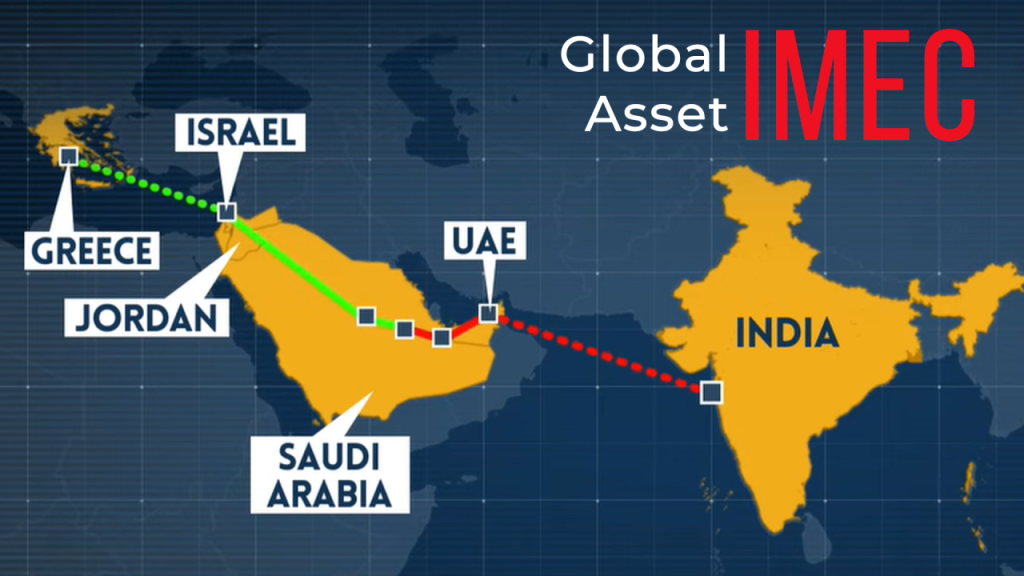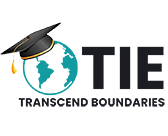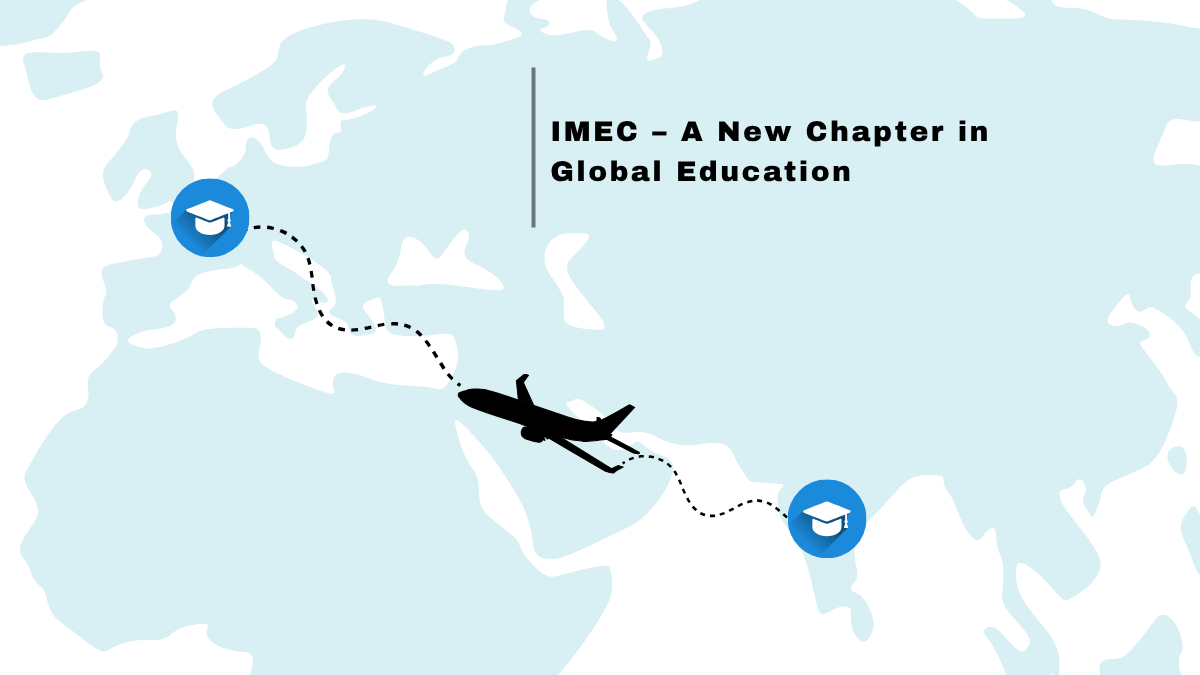From Infrastructure to Education—The Broader Vision of IMEC
The India-Middle East-Europe Corridor (IMEC) is not just a trade and infrastructure project—it’s a symbol of strategic connectivity for the 21st century. Announced at the 2023 G20 summit, it has gained attention due to its potential to accelerate logistics and commerce. However, what people usually overlook is that it has the power to revolutionise cross-border education.
IMEC, which connects India, the Middle East, and Europe via rail and maritime routes, could redefine how students move, learn, and grow across regions. Yet, the impact on education and student mobility remains underexplored in mainstream discourse.
As supply chains are reimagined, human capital chains must be part of the equation. Student flows—across disciplines, degrees, and destinations—may emerge as one of the corridor’s most significant long-term legacies.
Redefining Routes: The Corridor and the Countries it Connects
The IMEC is a strategic initiative connecting India, the UAE, Saudi Arabia, Jordan, Israel, Greece, and Italy. Unlike other global projects, IMEC does not just emphasise infrastructure but also the movement of people.
Participating Countries:
- India
- United Arab Emirates (UAE)
- Saudi Arabia
- Jordan
- Israel
- Greece
- Italy
How does the IMEC facilitate movement of people?
Student Exchanges:
Supporting students to study in different countries that take part in the programme.
Cultural Projects:
Promoting mutual understanding between institutions through both academic and cultural programs.
Research Teamwork:
Working collaboratively on research projects that focus on solving problems in the region.
Human Movement as a Long-Term Benefit
By prioritising human capital development, IMEC can:
Enhance Educational Opportunities:
Providing students with access to diverse academic environments.
Strengthen Regional Ties:
Building relationships through shared educational experiences.
Promote Economic Growth:
Developing a skilled workforce to meet regional demands.
This is how IMEC focuses on connecting people directly and plays an important role in education and cultural exchange.
Indian and Middle Eastern Student Mobility Trends
India:
In 2023, over 1.3 million Indian students pursued education abroad, making India one of the top sources of international students globally.
Middle East:
The number of students from Middle Eastern countries increased by more than 20% compared to the previous academic year.
Europe’s Growing Attractiveness
Europe is becoming an increasingly popular destination for Indian and Middle Eastern students due to a variety of factors, which include:
Affordable Education:
Countries like Germany and France almost no tuition fees for international students. For instance, public universities in Germany have minimal tuition fees, and France charges around €2,900–€3,900 per year for non-EU students.
Post-Study Work Opportunities:
Nations such as Austria provide a 12-month post-study work visa, allowing graduates to seek employment after completing their studies.
Simplified Visa Processes:
The European Union has simplified student visa rules, making it easier for international students to study there.
IMEC’s Academic Impact in Numbers
| Category | 2024 (Baseline) | 2030 Projection (High Adoption) |
| Indian outbound students | 1.3 million | 1.7–1.8 million |
| Middle East outbound students | ~400,000 | 600,000+ |
| Corridor student flows (IMEC) | ~50,000 | 300,000–400,000+ |
| Potential economic benefit | ~$1.5B USD | $9B–$12B+ annually |
Despite the growing interest, there are still several problems:
Visa Delays:
Complicated and inconsistent visa processes can discourage prospective students due to the hassle.
Limited Awareness:
Many students are unaware of the opportunities and benefits of studying in European nations.
Recognition of Qualifications:
Variations in how academic qualifications are recognised can create challenges for students moving between countries.
Potential of IMEC
The India-Middle East-Europe Corridor (IMEC) has the potential to address these challenges by:
Harmonising Visa Policies:
Introducing a unified “Corridor Visa” could simplify the application process.
Enhancing Infrastructure:
Investments in institutions and educational facilities in their particular regions can support the growing number of students.
Promoting Awareness:
Joint efforts can help more people become aware of the education options available in IMEC countries.
Forecasting the Future: How IMEC Can Accelerate Academic Migration
The (IMEC) is not just an infrastructure pipeline—it’s a potential pipeline for ideas, talent, and transformation in higher education. As student mobility becomes increasingly important for global influence, IMEC could trigger a regional shift in where students choose to pursue higher education.
Why it matters:
Student mobility has a lasting impact on diplomacy, innovation, and economic cooperation. Which means, if planned carefully, IMEC can become the primary route for students from South Asia and the Middle East travelling to Europe.
Factors That Could Drive Uptake
Ease of Transit:
Faster, more secure, and more affordable travel options will take down barriers for students from Tier-II and Tier-III Indian cities and secondary Middle Eastern regions.
Scholarship Ecosystems:
Corridor-based scholarships (like Erasmus+ or KAUST’s Vision 2030 grants) can bridge affordability gaps.
Public-Private Partnerships:
Collaborations between IMEC-linked universities and companies can expand internship-to-employment pathways.
New Corridors, New Campuses:
Universities may open regional campuses near transit hubs (e.g., NEOM in Saudi Arabia or ports in Greece) to attract students in the corridor.
Academic Migration: A Few Likely Shifts
Rise of Southern Europe:
Countries such as Italy, Greece, and even Portugal may see an increase in student numbers due to lower tuition fees and less saturated job markets.
Shift from US/UK to Corridor Nations:
Due to recent problems regarding student visas and living costs in the West, students are likely to opt for IMEC-linked nations offering similar quality at a lower price.
Increased Regional Loops:
Indian and Middle Eastern students may first study in the UAE or Saudi Arabia before continuing to European destinations—creating a “step-mobility” model.
Why Even Small Changes Matter
A 5–10% increase in mobility might look insignificant, but it turns into hundreds of thousands of students, each contributing to economic, cultural, and intellectual exchange.
For every 10,000 international students, host countries gain an average of $300 million in economic benefit annually. — NAFSA: Association of International Educators, 2023
Projected Student Mobility Growth Under IMEC Policy Scenarios (By 2030)
| Scenario Type | Description | Projected Increase in Student Mobility* |
| Low Adoption | Minimal policy coordination; infrastructure prioritised over people | 3–5% by 2030 (~50,000+ new students) |
| Medium Adoption | Partial policy sync, some corridor-specific scholarships and co-degrees | 10–12% by 2030 (~150,000–200,000) |
| High Adoption | Visa harmonisation, digital credentials, coordinated academic networks | 20%+ by 2030 (~300,000–400,000 students) |
Key Points to remember:
- IMEC’s success depends on how well education, visa, and technology policies are coordinated.
- Even tiny improvements in student mobility can create significant benefits over time.
- India, the UAE, Saudi Arabia, and Italy are likely to become important destinations for study abroad for students within this network.
What Makes These Hubs Stand Out?
As IMEC expands, some countries are becoming educational hotspots instead of just transit points. This provides students who are looking for more affordable and better alternatives, compared to the West.
United Arab Emirates
Based on QS Data, the UAE had over 80,000 international students in 2023. With IMEC, its universities have become even more appealing to students who want to study overseas, than they already were.
Here’s why:
- Home to over 60 international university campuses, including NYU Abu Dhabi and the University of Birmingham Dubai.
- Considerable investments in cross-border research, digital learning, and multilingual instruction.
- Potential to host corridor-specific scholarships, particularly for students from South Asian and Arab backgrounds.
Saudi Arabia: From Vision 2030 to Education Diplomacy
The Saudi Arabia’s Vision 2030 is rapidly transforming the kingdom into a centre of knowledge exchange.
Saudi Arabia is growing as a global education hub, with NEOM University and new global partnerships. More students from India and the Middle East are choosing it because it’s nearby, culturally familiar, and offers good job prospects.
According to Higher Ed Dive, from 2021 to 2023, the number of international students in the country grew by 15%. Also, the Custodian of the Two Holy Mosques Scholarship Program plans to support 70,000 students by 2030. This will make it easier for more people to go to university and help Saudi Arabia become an important place for international education.
Greece and Italy
Often overshadowed by the UK and Germany, Greece and Italy are increasingly appealing to students from IMEC countries.
Here’s why:
- Tuition fees are usually less than €4,000 annually, even for international students.
- Fields like STEM, medicine and business have a lot of English-taught programs (a number which is still increasing), making it an easily accessible option for foreign students.
- Visa regulations and options to stay after graduation are more favourable than in Western Europe.

Key developments to watch:
Italy’s “Invest Your Talent in Italy” programme is drawing tech and business students from India and the Gulf region.
Greece is strengthening university collaborations with the UAE and India to provide joint degree programmes.
A powerful dynamic is emerging: stepwise academic migration. Students may first study in the UAE or Saudi Arabia, then transfer to Italy or Greece for specialisation or internships supported by:
- Transit ease through IMEC routes
- Mutual recognition of credits
- Industry-linked education models
Summary Table: What Makes These Hubs Stand Out?
| Country | Edge in the Corridor Context | Type of Programmes Growing |
| UAE | Academic transit point; global campus density | Engineering, AI, Business |
| Saudi Arabia | Local scholarships + future-forward research zones | STEM, Public Policy, Health |
| Italy | EU access + scholarship-backed master’s programmes | Design, Tech, Management |
| Greece | Low cost + new bilateral academic ties | Humanities, Maritime, Tech |
Technology as an Enabler: Digital Infrastructure & Education Across Borders
The India-Middle East-Europe Corridor (IMEC) is not just about transport—it’s also using technology to make it easier for students to study across borders and get their qualifications recognised.
Blockchain and Digital Credentials: Trust Across Borders
One major challenge for students moving between countries is getting their degrees recognised, but using blockchain can help by making certificates secure and easy to verify.
The W3C Verifiable Credentials standard is being adopted by universities globally to authenticate diplomas.
In 2024, the UAE’s Ministry of Education launched a blockchain pilot for degree verification across Gulf countries.
This reduces bureaucratic delays and lowers the risk of credential fraud.
AI and Hybrid Learning Models
AI-powered platforms personalise learning, enabling students to blend online and in-person study—ideal for corridor students who may start studies digitally and complete them on-site.
According to HolonIQ, hybrid learning market revenue is expected to reach $20 billion by 2027.
Universities like NYU Abu Dhabi and King Abdullah University of Science and Technology (KAUST) are already piloting AI-enabled tutoring for international students.
Hybrid models can lower costs and increase accessibility, encouraging students to enter the IMEC corridor.
Digital Infrastructure and Visa Facilitation
Digital platforms are making visa applications easier, which is a big issue for students.
The UAE’s Smart Visa system allows students to get multi-entry academic visas that are linked to verified student records using blockchain.
Saudi Arabia is developing an integrated digital portal for students, faculty, and researchers under Vision 2030.
Easier digital access to visa information, application status, and document upload reduces the number of delays and builds trust among applicants.
AI-Scholarship Tools
AI-powered scholarship platforms like ScholarMatch help students find funding based on their location and interests.
Education tech companies are also working with universities along the route to offer training that fits job needs locally and globally. For example, Italy’s Invest Your Talent programme uses online tools to get Indian students ready for internships with European companies.
Technology is clearly a cornerstone of the future of student migration in the India-Middle East-Europe Corridor. By addressing traditional pain points, it expands opportunities for millions of students across the region.
Visas, Policies, and the Need for Harmonisation
One of the biggest hurdles to student mobility in India and across the India-Middle East-Europe Corridor (IMEC) is the current fragmented visa landscape. Having many countries involved means students face different visa types, approval steps, and rules, which often leads to delays and confusion.
Current Issues with Visa:
- Long visa wait times make it hard for students to enrol on time.
- Different rules across countries can be confusing.
- Most visas don’t allow easy travel across IMEC countries.
For example, Indian students in Europe often have to renew their visas every 6 to 12 months, which makes their lives harder as they now have to worry about visa processes rather than focusing on their career.
Policy Coordination for Smoother Movement
Successful corridors, such as the European Union’s Schengen Zone, demonstrate the power of harmonised policies. IMEC stakeholders can learn from this by:
- Standardising visa application criteria.
- Creating shared digital platforms for visa tracking and management.
- Coordinating scholarship and academic recognition policies.
With IMEC’s influence on scholarships and international student visa policies, this harmonisation can be a game changer to increase student mobility.
Summary Table: Technology as an Enabler
| Technology | Role in IMEC Corridor | Impact on Student Mobility |
| Blockchain Credentials | Secure, universal degree recognition | Faster admissions, reduced fraud |
| AI & Hybrid Learning | Personalized, flexible study modes | Access from remote areas, cost savings |
| Digital Visa Systems | Streamlined, transparent visa applications | Lower barriers, quicker travel |
| AI Scholarship Tools | Matching students with corridor-specific funding | Increased scholarship uptake |
Culture, Diaspora, and Academic Diplomacy
Culture and diaspora networks play a crucial role in deepening academic ties across the India-Middle East-Europe Corridor (IMEC). These connections make student mobility more sustainable and enriching.
Leveraging Cultural Exchange & Diaspora Links
- Diaspora communities act as bridges, helping students navigate new environments.
- Cultural familiarity reduces adjustment barriers, increasing enrolment from India and the Middle East.
Example: The Indian diaspora in the UAE supports mentorship programs for Indian students.
Dual Degrees, Intercultural Curricula & Arts Collaborations
- Universities within IMEC can provide dual degrees that bring together the academic strengths of different countries.
- Intercultural courses help develop global skills, which is very important for MBA students who are planning international careers.
- Art collaborations encourage cultural exchange and strengthen ties between countries.
- Scholarships funded by diaspora groups often support students from the corridor.
- Mentorship programmes run by alumni and diaspora networks help improve student success and keep them engaged.
Example: Saudi Arabia’s Vision 2030 includes scholarship programs for students from the Middle East to study at universities in Europe.
Potential Pitfalls: Political Risk, Brain Drain, and Implementation Gaps
While the India-Middle East-Europe Corridor (IMEC) is promising, there are still challenges that could negatively affect student mobility, both in India and the corridor.
Political Risks and Regional Instability
Geopolitical tensions in the Middle East may negatively impact student exchanges and collaborations.
Policy shifts can also affect visa agreements and funding.
Example: Sudden changes in visa rules have previously affected student flows between India and Europe.
Brain Drain vs Circular Migration
Brain drain is the phenomenon of students who study abroad and don’t go back to their home countries.
Circular migration helps solve this issue by allowing students to study abroad, gain skills, and keep close connections with their home countries, often returning or contributing from afar.
IMEC is designed to support this circular movement by making it easier for students to return and continue working with institutions at home.
Implementation Gaps and Unequal Access
- Differences in facilities and internet access might leave out disadvantaged groups.
- The advantages might mostly go to richer cities, leaving poorer areas behind.
- It’s important to introduce changes step by step and start with trial programs to fix these problems well.
What Needs to Be Done Now
For the IMEC to improve higher education and student mobility in India, every relevant party must work together.
For Governments:
- Make visa rules simpler by creating a “Corridor Visa” that lets students and staff travel easily for study across the countries, like Europe’s Schengen Visa.
- Create scholarships specifically for students in the corridor to improve access.
- Hold education meetings to help countries in the corridor work together and agree on shared policies.
For Universities:
- Create joint degrees and shared campuses across the corridor, which will lead to more academic choices for students.
- Support regional research projects that address challenges related to the corridor.
- Create cross-cultural courses that help prepare students who want to pursue international careers.
For the Private Sector:
- Provide funding for internships and work placements that connect corridor students with leading businesses.
- Develop educational technology to encourage cross-border learning.
- Build job market linkages that facilitate post-study employment within the corridor.
IMEC as a Blueprint for Human-Centric Globalisation
The IMEC is more than a trade and infrastructure project. It can transform education by improving student mobility both in India and throughout the corridor.
IMEC can:
- Make international education more accessible and affordable for everyone.
- Encourage cross-border collaboration that benefits students, institutions, and economies alike.
- Build a model of globalisation that is human-centred, where students needs and cultural exchange are prioritised.
For IMEC to be successful, all involved parties must balance improving transport links with creating policies and practices that support the students, faculty, and researchers who use them.
In this way, the corridor will not only connect regions but also create a vibrant, inclusive educational ecosystem that defines the future of higher education IMEC.
Written by Manjul Kathotia.

